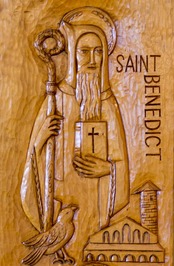Memorial of St. Benedict, Abbot
-
 July 11, 2025Saint Benedict was born in 480 in Nursia, Italy to a Roman noble family and had a twin sister, Saint Scholastica. The family later moved to Rome where he studied.
July 11, 2025Saint Benedict was born in 480 in Nursia, Italy to a Roman noble family and had a twin sister, Saint Scholastica. The family later moved to Rome where he studied.
Benedict’s first miracle occurred when a servant had broken a sieve into pieces. He gathered the pieces and prayed over them; miraculously making it whole again. He decided to leave his family's wealth and status to live a hermetic life in a cave in the mountains of Subiaco. For three years he lived in the cave, having a raven as a companion. The cave formed him, in mind and spirit, leading to a reputation of high respect.
Benedict authored the Rule of Saint Benedict, which outlines monastic life and governance. He went to Mount Cassino to establish a monetary. The devil tried to thwart the construction, placing obstacles. At the end, Benedict sensed the devil and warned the monks of the danger. At that moment, a piece of the wall fell, killing a monk. He prayed over the corpse, reviving him.
He visited his twin sister, Saint Scholastica, for the last time three days prior to her death. He sensed his own death and announced it to the monks. He fell ill the same day; six days later he had succumbed to his illness. He was laid to rest with his sister.
St. Benedict is known as the patron saint against curses, against erysipelas, against fever, against gallstones, against inflammation, against inflammatory diseases, against kidney disease, against nettle rash, against pain, against poison, against temptations, against witchcraft, agricultural workers, architects, the Benedictines, civic engineers, coppersmiths, cavers, the dying, Europe, farm workers, the Institute of Christ the King Sovereign Priest, the National Federation of Knights of Labor, monastics, the Olivetans, religious, servants who have broken their master’s belongings, the Society of the Sacred Heart, speleologists, spelunkers, and students.
Celebrate the memorial by:- Learning more about Saint Benedict online here.
- Praying for more vocations into religious life
- Attending Mass at St. Joseph Abbey, a Jubilee Pilgrimage site, with the Benedictine monks.
